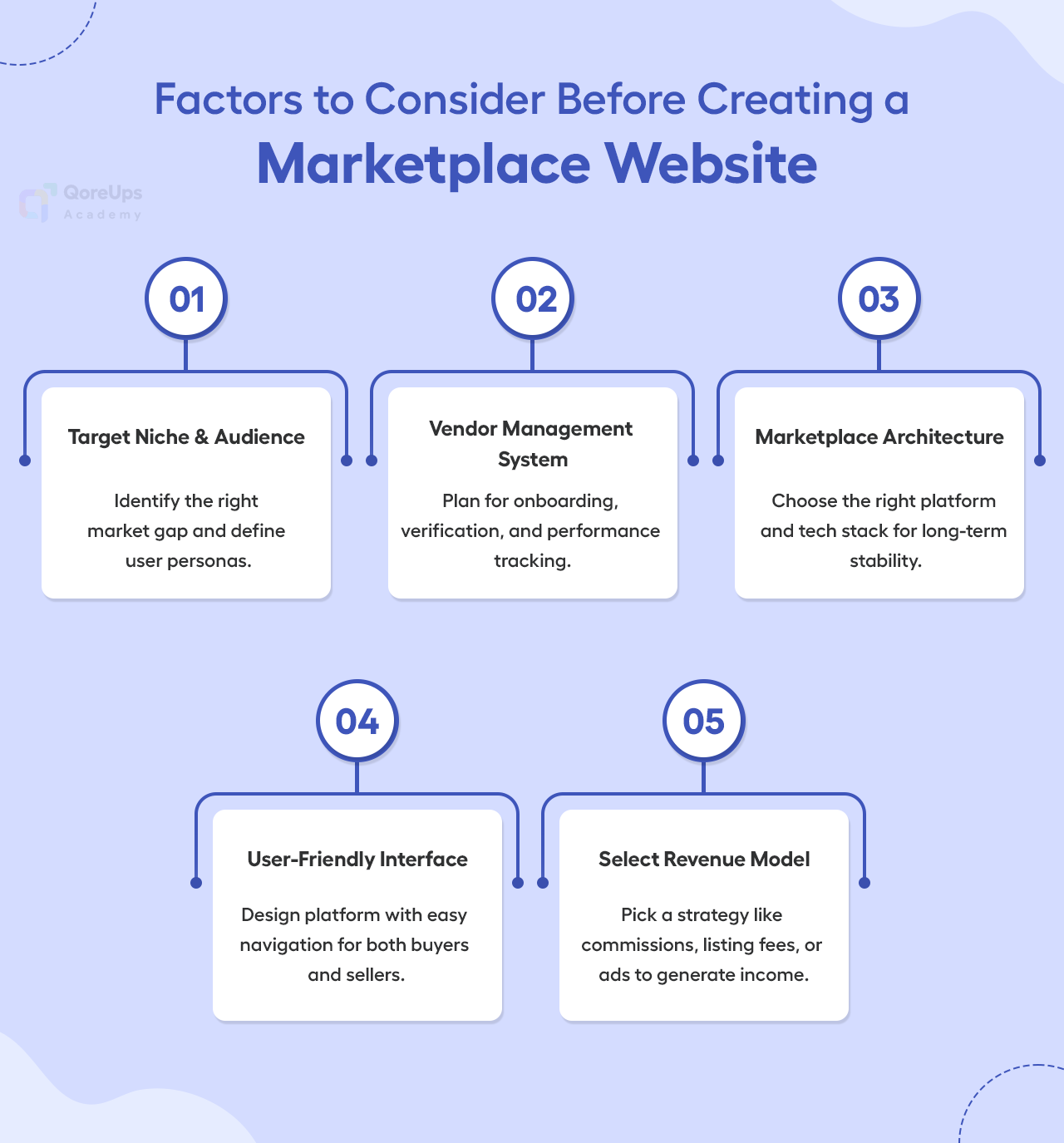In today’s digital economy, the multi-vendor marketplace website has become the backbone of e-commerce.
Platforms like Amazon, Etsy, and eBay exemplify how powerful a marketplace model can be, bringing together sellers and buyers in one centralized online environment.
If you’re considering entering this dynamic domain, understanding how to create a multi-vendor marketplace website is the first critical step.
This guide walks you through everything you need to know—from what a multi-vendor marketplace is to its advantages, vital pre-launch considerations, and how to actually build one, especially with modern solutions like QoreUps.
Get set — we’re about to launch!
What Is a Multi-Vendor Marketplace Website?
A multi-vendor marketplace is an e-commerce platform where multiple independent vendors can sell their products or services.
Rather than a traditional online store where the platform owner stocks and sells products, a multi-vendor marketplace enables other sellers to list their offerings while the platform manages the infrastructure, payments, and customer support.
These websites serve as a bridge between buyers and sellers, providing value by handling transactions, ensuring security, and offering a seamless user experience.
Popular examples include Amazon, AliExpress, and Flipkart.
Advantages of Building a Multi-Vendor Marketplace Website

Creating a multi-vendor platform comes with a range of benefits, both strategic and operational. Let’s explore the key advantages that make this model so attractive for entrepreneurs and investors:
1. Scalable Business Model
One of the most appealing aspects is its inherent scalability.
Since you don’t have to manage inventory, you can rapidly expand your product catalog by onboarding more vendors.
This allows your platform to grow in parallel with your vendor network.
Amazon started by selling books but quickly scaled to offer electronics, fashion, home goods, and more, all by enabling third-party vendors to list their inventory in its marketplace.
2. Low Operational Costs
The marketplace owner is not responsible for storing, packing, or shipping products.
Vendors take that commitment and handle their own inventory and logistics.
You primarily focus on platform maintenance, vendor support, and customer experience.
Costs That You Save On:
- no need for a full staff
- no procurement costs
- no warehouse rental
You can utilize these savings to invest in better marketing and platform improvements.
3. Diverse Product Range
When multiple vendors sell on your platform, they bring their unique inventories, resulting in a diverse product range.
This attracts a broader customer base with varied preferences.
It increases overall site traffic and customer engagement.
The Impact:
With more options available, buyers are more likely to return to your marketplace, boosting retention and average order value.
4. Revenue from Multiple Streams
Multi-vendor platforms open up several monetization avenues:
- Fees for premium features like same-day shipping
- Subscription plans for buyers and vendors
- Commissions on each transaction
- Featured listings and ads
This revenue diversity ensures a consistent cash flow and makes your business more resilient to market changes.
5. Improved Customer Experience
A multi-vendor platform naturally fosters competitive pricing, better quality, and faster shipping due to vendor competition.
Customers benefit from a one-stop shop experience.
They can find and buy everything in one marketplace with reliable service.
Etsy provides a personalized shopping experience with diverse, handcrafted items, attracting millions of repeat customers.
Best Multiple Marketplace Software Solutions
Factors to Consider Before Creating a Marketplace Website

Before jumping into development, you need a solid foundation. Let’s break down the key elements to ensure your marketplace succeeds.
1. Target Niche & Audience
The most successful marketplaces solve specific problems or cater to specific communities.
Defining a niche allows you to:
- curate vendor onboarding
- tailor the platform design
- do marketing effectively
Tips:
- Start by identifying a market gap.
- Use surveys, competitor research, and Google Trends to validate demand.
- Define user personas to effectively design a marketplace for your ideal customer and seller profiles.
2. Vendor Management System
You’ll need a robust backend to manage vendor operations efficiently.
This includes:
- onboarding workflows
- verification systems (to avoid fraud)
- performance tracking (ratings, returns, delivery rates)
Good vendor management leads to reliable sellers and, in turn, a better customer experience.
Pro Tip:
- Automate onboarding with digital forms.
- Implement tiered vendor levels based on performance to encourage growth.
3. Marketplace Architecture
The choice of technology is critical.
Consider platforms like Magento, Shopify with Marketplace apps, WordPress with Dokan, or modern no-code/low-code builders like QoreUps.
Essential architectural needs:
- high scalability
- modular design
- secure and fast hosting
- payment gateway integrations
Long-term View:
Choose a marketplace platform that allows for customization and growth, not just fast deployment.
4. User-Friendly Interface
User experience is a win-or-lose factor for your platform. Both vendors and customers need an intuitive interface.
Fundamental Buyer Features:
- smooth checkout
- wishlist/favorites
- real-time tracking
- mobile-friendly interface
- secure payment gateway
- advanced search and filters
- customer reviews & ratings
- personalized recommendations
- multi-language & multi-currency support
- 24/7 customer support or chatbot assistance
Fundamental Vendor Features:
- easy product upload
- mobile vendor access
- price & tax configuration
- dashboard with analytics
- sales performance reports
- promotions & discount tools
- product review management
- payout & commission tracking
- customer communication panel
- inventory and order management
Tip:
Use UI/UX best practices and perform usability testing regularly.
5. Select Revenue Model
How will your platform make money?
Choosing the right revenue model is essential for long-term sustainability. Your choice should align with your market, value proposition, and vendor expectations.
Popular revenue models include:
- Listing fees: Charge vendors per product listed.
- Commission-based: Earn a percentage of each sale.
- Advertisement model: Let vendors pay for featured spots or ads.
- Subscription-based: Charge vendors a monthly or yearly platform fee.
Pro Tip:
You can make income by combining multiple revenue models. Start simple and scale your monetization strategy based on vendor adoption.
How to Build a Multi-Vendor Marketplace Website
Once you’ve laid the groundwork with solid planning and strategy, the real action begins — bringing your marketplace to life. Below is a practical, step-by-step roadmap to help you turn your marketplace idea into a fully functional, revenue-generating platform.
1. Define Your MVP (Minimum Viable Product)
Start with clarity.
What are the absolute essential features your platform must have to go live and offer value?
Your MVP isn’t about launching with everything — it’s about launching smart.
Focus on core components like:
- Vendor registration and onboarding
- Shopping cart and checkout
- Product listing capabilities
- Basic admin dashboard
- Payment integration
Tip:
Don’t overbuild. Launch lean, then grow based on actual user feedback and behavior.
2. Choose the Right Platform
This decision can make or break your project timeline and budget.
You have two main paths:
- Custom development gives you total control but is costly and time-consuming.
- No-code builders like QoreUps allow you to launch faster without hiring a full dev team.
QoreUps offers a “plug-and-play marketplace builder” with multi-vendor features baked in, allowing you to skip the tech hurdles.
7 Tips To Select The Marketplace Website Builder
3. Design UI/UX That Works for Everyone
User experience can’t be an afterthought. A clunky interface will drive both vendors and buyers away.
- Keep navigation intuitive
- Optimize for mobile responsiveness
- Use designs that align with your brand identity
- Ensure product pages are clean and informative
Great UI/UX makes your platform feel premium, professional, and trustworthy from the first click.
4. Set Up Vendor & Buyer Flows
Build smooth pathways for both sides of the marketplace:
- Vendor Flow: Registration → Verification → Product listing → Order management
- Buyer Flow: Registration → Search → Product page → Add to cart → Checkout → Order tracking
Simplify as much as possible to reduce manual intervention and errors. A good experience here increases adoption and reduces churn.
5. Integrate Payment Gateways
Secure and seamless transactions are absolutely critical. Payment gateways play a crucial role in ensuring that both buyers and vendors can process transactions quickly, safely, and without hassle.
Integrate trusted gateways like:
- Stripe
- PayPal
- Razorpay
- Region-specific providers for wider accessibility
6. Launch a Beta Version
Before a full-scale launch, roll out a beta.
Invite a limited number of vendors and buyers to test the platform in a real-world environment.
- Collect feedback on usability
- Identify bugs or friction points
- Test scalability under real traffic
Use this phase to validate your MVP and make essential tweaks before going public.
7. Iterate and Improve
Once live, the real learning begins.
Use analytics and user feedback to continuously enhance your marketplace.
- Optimize existing flows
- A/B test pricing, CTAs, and layouts
- Add new features based on demand
- Improve performance and loading speed
Growth is an ongoing process. Your marketplace should evolve with user expectations and industry trends.
How Much Does It Cost to Build a Marketplace Website?
Build Your Best Multi-Vendor Marketplace Website with QoreUps
If you’re looking to build a marketplace without the headache of managing custom code or expensive developers, QoreUps offers a powerful solution.
Why QoreUps?
- Pre-built Marketplace Features: Product management, vendor onboarding, payment gateways, reviews, dashboards — all included.
- Customizable UI: Tailor the design to your brand.
- Quick Deployment: Launch in hours, not months.
- Scalable Backend: Built to grow with your business.
- Secure and Reliable: Hosted on cloud infrastructure with 24/7 support.
Whether you’re building a B2B wholesale marketplace, niche product platform, or local services portal, QoreUps provides everything needed to build, scale, and monetize your platform.
Final Thoughts
The multi-vendor marketplace model offers incredible opportunities for digital entrepreneurs.
With lower upfront costs, diverse revenue streams, and a scalable architecture, it’s no wonder this model continues to thrive.
However, success lies in planning, execution, and ongoing optimization.
By understanding the core benefits and challenges, and leveraging a modern marketplace website builder like QoreUps, you’re well on your way to launching a profitable and impactful online marketplace.
Build your marketplace the smart way — launch with QoreUps today!!!






